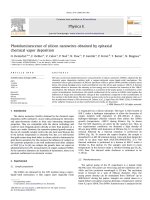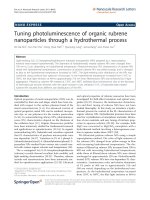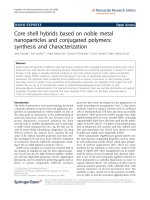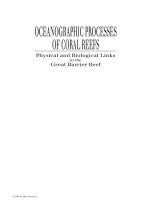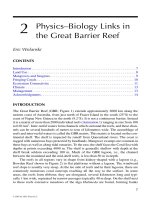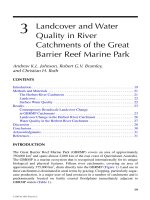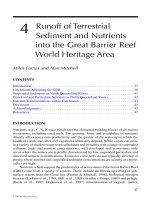Aggregation enhanced two photon excited photoluminescence of noble metal nanoparticles and their chemical and biological applications
Bạn đang xem bản rút gọn của tài liệu. Xem và tải ngay bản đầy đủ của tài liệu tại đây (6.5 MB, 145 trang )
I
Declaration Page
I hereby declare that this thesis is my original work and it has been written by me in
its entirety, under the supervision of Associate Professor Xu Qing-Hua, (in the
laboratory S7-04-07), Chemistry Department, National University of Singapore,
between 3/08/2009 and 14/08/2013.
I have duly acknowledged all the sources of information which have been used in the
thesis.
This thesis has also not been submitted for any degree in any university previously.
The content of the thesis has been partly published in:
1) Cuifeng Jiang, Zhenping Guan, Siew Yin Rachel Lim, Lakshminarayana
Polavarapu and Qing-Hua Xu. Two-photon ratiometric sensing of Hg
2+
by using
cysteine functionalized Ag nanoparticles. Nanoscale, 2011, 3, 3316-3320.
2) Cuifeng Jiang, Tingting Zhao, Peiyan Yuan, Nengyue Gao, Yanlin Pan, Zhenping
Guan, Na Zhou, and Qing-Hua Xu. Two-Photon Induced Photoluminescence and
Singlet Oxygen Generation from Aggregated Gold Nanoparticles. ACS Appl.
Mater. Interfaces 2013, 5, 4972 − 4977.
3) Cuifeng Jiang, Tingting Zhao, Shuang Li, Nengyue Gao, and Qing-Hua Xu.
Highly Sensitive Two-Photon Sensing of Thrombin in Serum Using Aptamers
and Silver Nanoparticles. ACS Appl. Mater. Interfaces, 2013, 5, 10853-10857.
Name
Signature
Date
Jiang Cuifeng
11, Feb, 2014
II
ACKNOWLEDGEMENTS
This section is dedicated to these important persons who play very important roles
over the past four years. I am grateful to them.
The first person I want to express deep and sincere gratitude is my supervisor-Prof
Xu Qing-Hua
f
or his support, encouragement and guidance both in research area and
life. I have learnt a lot from his detailed and constructive comments. His enthusiasm,
hard work and rigorous methodology in scientific research always encouraged me.
More importantly, Prof Xu has provided much value advice on facing problems in
research and life. These advices helped me to get through a hard time. I really
appreciate Prof Xu.
I would like to acknowledge the financial, academic and technical support of the
National University of Singapore, and its staff. I also thank the Department of
Chemistry and its academic and administrative staff for the kind support and
assistance since the start of my studies at NUS.
I wish to thank all my past and present lab mates, Dr. Lakshminaraya Polavarapu,
Dr. Ren Xinsheng, Dr. Li Lin, Dr. Lee Yih Hong, Dr. Yu Kuai, Dr. Shen Xiaoqin, Dr
Zhao TingTing, Ms. Ye Chen, Mr. Guan Zhenping, Ms. Yuan Peiyan, Mr. Chen
Jianqiang, Mr. Gao Nengyue, Ms. Jiang Xiaofang, Ms. Zhou Na, Mr. Pan Yanlin,
Ms. Li Shuang, Mr. Ma Rizhao, Ms. Han Fei, Dr. Tang Fu, Dr. Wang Qisui and all
my friends in NUS for their help, continuous encouragement and support.
Finally but most importantly, I would like to express my appreciation to my family-
my parents, my husband, my daughter, my parents-in law and my sister. My parents
always support me in the past 30 years. It is my sister who always look after my
parents when I am absent for most time. My husband encouraged me almost everyday
in the past 4 years. His continuous efforts on baby, parents and family are biggest
support for me. My daughter is a lovely girl and she is my motivation in the past year.
My parents in-law support me wholeheartedly to finish the four years’ study, their
help on taking care of my daughter make me focus on my research. I am lucky to have
these family and no words can express the appreciation to them.
III
TABLE OF CONTENTS
THESIS DECLARATION ·····················································I
ACKNOWLEDGEMENT ····················································II
TABLE OF CONTENTS ····················································IV
SUMMARY ·····································································VI
LIST OF TABLES ·····························································IX
LIST OF FIGURES ····························································X
LIST OF SCHEMES ·······················································XIV
LIST OF PUBLICATIONS ·················································XV
Chapter 1 Introduction
1
1.1 Noble metal nanoparticles
1
1.1.1 Localized Surface Plasmon Resonance 1
1.1.2 Plasmon Coupling and its Optical Properties 5
1.2 Singlet Oxygen and its Application
11
1.3 Noble Metal Nanoparticles Based Sensing Method
13
1.3.1 Overall introduction of nanoparticles in sensing 14
1.3.2 Cross linking aggregation based sensing 16
1.3.3 Non-cross linking aggregation based sensing 20
1.4 Two-Photon Excited Photoluminescence
23
1.4.1 Two-Photon Absorption 23
1.4.2 Plasmon Coupling Induced Enhancement of Two-Photon Excited
Photoluminenscence 28
1.4.3 Measurement of Two-Photon Excited Photoluminescence 30
1.5 Applications of Two-Photon Photoluminescence
30
1.6 Thesis Outline
32
IV
References 35
Chapter 2: Two-Photon Induced Photoluminescence and Singlet
Oxygen Generation from Aggregated Gold Nanoparticles
45
2.1 Introduction
46
2.2 Experiment Section
47
2.2.1 Materials 47
2.2.2 Preparation and assembly of gold nanoparticles 48
2.2.3 Detection of singlet oxygen generation 48
2.2.4 Instrumentations and characterizations 49
2.3 Results and discussion
49
2.4 Conclusions
61
References 63
Chapter 3 Simple Two-Photon Sensing of Dopamine using Au
nanoparticles
67
3.1 Introduction
68
3.2 Experiment Section
69
3.2.1Materials 69
3.2.2 Preparation of Au nanoparticles: 70
3.2.3 Detection of dopamine: 70
3.2.4 Instrumentations and characterizations 70
3.3 Results and Discussion
71
3.4 Conclusions
78
References 79
Chapter 4 Two-Photon Ratiometric Sensing of Hg2+ by Using
Cysteine Functionalized Ag Nanoparticles
82
4.1 Introduction
83
4.2 Experiment Section
84
4.2.1 Materials 84
V
4.2.2 Preparation of cysteine functionalized Ag nanoparticles 85
4.2.3 Cell Culture and preparation of samples for two-photon excitation microscopy: 86
4.2.4 Instrumentation and characterizations 86
4.3 Results and Discussion
88
4.4 Conclusions
100
References 102
Chapter 5 Highly Sensitive Two-photon Sensing of Thrombin in
Serum using Aptamers and Silver nanoparticles
105
5.1 Introduction
106
5.2 Experiment Section
108
5.2.1 Materials 108
5.2.2 Preparation of silver nanoparticles 108
5.2.3 Detection of thrombin 108
5.2.4 Instrumentations and characterizations 109
5.3 Results and Discussion
110
5.4 Conclusions
123
References 124
Chapter 6 Conclusion
128
VI
Summary
As noble metal nanoparticles, Au and Ag nanoparticles exhibit some unique
optical properties, such as localized surface plasmon resonance (LSPR), which results
from the conduction band electrons’s collective oscillation. The LSPR band is
dependent on the morphology (size and shape) of particles, and dielectric environment
of the particles. Plasmon coupling of adjacent noble metal nanoparticles can also
result in a red or blue shifted localized surface Plasmon resonance peak and
significantly enhanced local electrical field within the gap region. The enhanced local
electrical field can enhance the two-photon photoluminescence (TPPL). It is of great
importance to investigate Plasmon coupling enhanced TPPL and their application in
chemical and biological application.
Plasmon coupling of noble metal nanoparticles can enhance two-photon
photoluminescence (TPPL) significantly. Two photon emission advantages one
photon emission for its narrow beam of high intensity light and deeper penetration.
This thesis presents a study on the application of aggregation induced enhancement of
two-photon photoluminescence of noble metal nanoparticles.
Firstly, two-photon excited photoluminescence and two-photon induced singlet
oxygen generation of Au nanospheres and two ratios of Au nanorods before and
after aggregation were invested in Chapter 2. Aggregation effects of noble metal
nanoparticles are generally believed to be adverse to biomedical applications,
however, Au nanospheres and short Au nanorods displayed enhanced two-photon
excited photoluminescence and singlet oxygen generation efficiency after aggregation.
The two-photon photoluminescence of Au nanospheres and short Au nanorods were
enhanced by up to 15.0- and 2.0-fold upon aggregation, and the corresponding
two-photon induced singlet oxygen generation capabilities were enhanced by 8.3- and
1.8-fold, respectively. The two-photon induced photoluminescence and singlet
oxygen generation of the aggregated long Au nanorods were found to be lower than
the unaggregated ones. These results support that the change in their two-photon
induced photoluminescence and singlet oxygen generation originate from aggregation
VII
modulated two-photon excitation efficiency. Based on these results, we designed a
series of TPPL assay for detection of dopamine, mercury ions and thrombin.
In chapter 3, a non-cross linking aggregation based TPPL assay for dopamine was
demonstrated. Protonated dopamine molecules can bind bidentately to surface of gold
atoms through the catechol group. The adsorption of dopamine displaces citrate
groups, which stabilize the Au NPs, and neutralize the charge of solution, leading to
non-cross linking aggregation of Au NPs. When Au NPs solution was mixed with
dopamine, TPPL intensity increases by about 47 times. The TPPL assay was highly
selective to dopamine and it can distinguish from uric acid, ascorbic acid and metal
ions.
A novel cross-linking based two-photon sensing strategy to detect mercury ions
with high selectivity and sensitivity was developed in Chapter 4. This sensing
approach is based on the observation that addition of Hg
2+
into a cysteine
functionalized Ag nanoparticle solution could significantly enhance their two-photon
emission. An enhancement factor up to 100 folds was obtained when mercury was
added. The sensitivity and sensing range can be easily tuned. Compared to the
conventional colorimetric or extinction spectra based methods, this scheme offers
improved sensitivity, quantitative detection of Hg
2+
with a larger dynamic range, and
allows detection deep into biological environments such as cells and tissues where
deep penetration is required. The sensitivity could be further improved by using
two-photon microscopy with the additional advantages of 3D detection and mapping.
In chapter 5, we demonstrated a label free, fast, highly sensitive and selective
two-photon sensing scheme for selective detection of thrombin on the picomolar level.
The assay is based on selective interactions between thrombin and a DNA aptamer,
which
induce aggregation of Ag NPs and result in significantly enhanced two-photon
photoluminescence. The LOD of our two-photon sensing assay is as low as 3.1 pM in
the buffer solution, more than 360 times lower than that of the extinction method (1.3
nM). The dynamic range of this method covers more than 4 orders of magnitude.
Most importantly, this two-photon sensing assay can be applied to detection of
VIII
thrombin in fetal bovine serum with LOD of 0.1 nM. In addition to the unique
advantages of two-photon sensing such as deep penetration and localized detection,
this method could be potentially combined with two-photon microscopy to offer
additional advantages of 3D detection and mapping for potential in-vivo sensing
applications.
IX
List of Tables
Table 1.1 Penetration depth (mm) at various wavelength. 25
Table 2.1 Optical properties of Au nanoparticles. 54
Table 5.1 Recovery of Human α–Thrombin Spiked into Fetal bovine serum samples
.
116
X
List of Figures
Figure 1.1 Au nanocrystals with different shapes and sizes: (A) nanospheres; (B)
nanocubes; (C) nanobranches; (D—F) nanorods with increasing aspect
ratios; (G—J) nanobipyramids with increasing aspect ratios. (K)
Normalized extinction spectra of the nanospheres (black), nanocubes
(red), and three nanorod samples (green, blue and purple). (L)
Normalized extinction spectra of the four nanobipyramid samples (red,
green, blue and purple) and nanobranches (black). 3
Figure 1.2 (A, B) Normalized extinction spectra and (C, D) TEM images of isolated
Au NSs (panels A and C) and Ag NSs (panels B and D) of different
sizes . 4
Figure 1.3 Electrodynamic modeling calculations for Au nanoparticles. (A) Change
of extinction spectra for 20 nm diameter particles with inter-particle
distance. Inset is the peak shift vs inter-particle distance. (B) Influence
of Au nanoparticle diameter on the extinction spectra at fixed (0.5 nm)
interparticle diameter. (C) Extinction spectra of “line aggregates” of
varying number. Inset is the peak shift against the number of Au
particles in the line aggregate. 7
Figure 1.4 (a) Hot spots in a Raman image of Au nanoparticles arising from (b)
condensed nanoparticle pairs (c) FDTD calculations of adjacent
nanoparticle pairs showing a hot spot in the junction for incident
polarization along the inter-particle axis; (d) for incident polarization
orthogonal to the inter-particle axis, no hot spot occurs. 9
Figure 1.5 Jablonski energy diagram for one-photon and two- photon absorption.
23
Figure 1.6 Optical setup of a TPPL experiment. 26
Figure 2.1 TEM images of isolated (a, c, e) and aggregated (b, d, f) Au NSs (a, b),
short Au NRs (c, d) and long Au NRs (e, f). 46
Figure 2.2 Extinction spectra of Au NSs (a) short Au NRs (b) and long Au NRs (c)
before and after addition of different amounts of cysteine. 48
Figure 2.3 TPPL spectra of (a) Au NSs (b) short Au NRs and (c) long Au NRs
under excitation at 800 nm using femtosecond laser pulses (power
density: 50 mW); (d) excitation power dependence of TPPL for
aggregated Au NSs, short and long Au NRs. Error bars represent
standard deviations for measurements taken from three independent
experiments. 48
XI
Figure 2.4 Extinction spectra of ABDA in the presence of (a) isolated Au NSs (b)
aggregated Au NSs (c) isolated short Au NRs (d) aggregated short Au
NRs (e) isolated long Au NRs (f) aggregated long Au NRs under
illumination of 800 nm femotosecond laser. 51
Figure 2.5 Photo-oxidation of ABDA as a function of irradiation time in the
presence of isolated (un-aggregated) and aggregated Au NSs (a) short
Au NRs (b) and long NRs (c) A
0
and A is the absorbance of ABDA at
380 nm before and after laser irradiation, respectively. Error bars
represent standard deviations for measurements taken from three
independent experiments. 53
Figure 2.6 Enhancement factor of two-photon photoluminescence (TPPL) and
two-photon induced
1
O
2
generation (TP-
1
O
2
) for Au NSs, short Au NRs
and long Au NRs upon aggregation. Error bars represent standard
deviations for measurements taken from three independent
experiments.
55
Figure 3.1 (a) Photographs of Au NPs in the presence of 0, 8, 25, 36 mM of
dopamine; (b) Extinction spectra of Au NPs with different
concentration of dopamine; (c) Plot of the extinction ratio A
736nm
/A
518nm
versus [dopamine]. The inset shows that A
736nm
/A
518nm
is direct
proportion to [dopamine] in the low concentration range.
66
Figure 3.2 TEM images of Au NPs in the (a) absence and (b) presence of 36 mM
dopamine. 68
Figure 3.3 TPPL spectra of Au NPs solution (a, b) upon addition of different
concentration of dopamine; (c) Plot of TPPL enhancement factor
versus [dopamine].The inset exhibits that enhancement factor of TPPL
is direct proportion to [dopamine]
in a low concentration range.
70
Figure 3.4 The power dependence of the TPPL of Au NPs under excitation at
810nm for a sample with 36 mM of dopamine. 70
Figure 3.5 (a) TPPL spectra and (b) TPPL enhancement factors for Au NPs in the
presence of 25 mM dopamine, or 250 mM other analytes. 71
Figure 4.1 (a) Photographs of Ag NPs with different concentration of Hg
2+
; (b)
Extinction spectra of Cys-Ag NPs in the presence of different
XII
concentration of Hg
2+
. (c) Plot of extinction ratio A
550nm
/A
360nm
versus
[Hg
2+
]. 84
Figure 4.2 TEM images of cys-Ag in the (a) absence and presence of (b) 3 mM (c) 5
mM (d) 35 mM of Hg
2+
. 85
Figure 4.3 (a) TPPL spectra of cys-Ag NPs in the absence and presence of Hg
2+
; (b)
Plot of TPPL enhancement factor versus [Hg
2+
]. The inset is the linear
dependence in the low Hg
2+
concentration regime. [cysteine] = 35μM.
86
Figure 4.4 Power dependence of the TPPL of cys- Ag NPs under excitation at 800
nm for the sample with 20 mM of Hg
2+
. [cysteine] = 35 μM. 87
Figure 4.5 (a) TPPL spectra of cys-Ag in the absence and presence of Hg
2+
and (b)
Plot of TPPL enhancement factor versus [Hg
2+
] ([cysteine] = 7 μM) (c)
TPPL spectra of cys-Ag in the absence and presence of Hg
2+
and (d) Plot
of TPPL enhancement factor versus [Hg
2+
] ([cysteine] = 175 μM). The
inset is the linear dependence in the low Hg
2+
concentration regime.
89
Figure 4.6 TPPL enhancement factor for cys-Ag in presence of various metal ions.
Inset is the corresponding TPPL spectra. [Metal ions] = 68 μM.
90
Figure 4.7 Two-photon excitation microscopy of cys- Ag NPs in the absence (a) and
presence of 0.5 mM (b) and 10 mM(c) of Hg
2+
.
91
Figure 4.8 UV-Vis extinction spectra of citrate capped Ag NPs in presence of Hg
2+
with different concentrations. 92
Figure 4.9 (a) TPPL spectra of citrate-Ag NPs in the presence of different
concentration of mercury ions. (b) Plot of TPPL enhancement factor
versus [Hg
2+
]
.
93
Figure 4.10 (a) Extinction spectra of cys- Au NPs in absence and presence of Hg
2+
.
(b) Plot of extinction ratio A
600nm
/A
526nm
versus [Hg
2+
] using cys-Au
NPs. 93
Figure 4.11 (a) TPPL spectra of cys-Au NPs in the presence of different
concentration of mercury ions. (b) Plot of TPPL enhancement factor
versus [Hg
2+
]. 94
XIII
Figure 5.1 (a) Photographs and (b) Extinction spectra of Ag NPs in the presence of
different concentrations of thrombin; The extinction ratio A
483nm
/A
395nm
versus [thrombin] was plotted in (c). The inset shows that A
483nm
/A
395nm
is direct proportion to [thrombin] in the low concentration range.
106
Figure 5.2 TEM images of Ag NPs (a) in the absence and (b) presence of 70 nM
thrombin. 107
Figure 5.3 (a, b) TPPL spectra of Ag NPs solution upon addition of different
concentration of thrombin; (c) Plot of TPPL enhancement factor versus
[thrombin]. The inset exhibits that the TPPL enhancement factor is
direct proportion to [thrombin] in the low concentration range. 108
Figure 5.4 Power dependence of the TPPL of Ag NPs under excitation at 810 nm in
resence of 60 nM thrombin (Power density: 23, 30, 36, 43, 47 mW).
110
Figure 5.5 (a) TPPL spectra and (b) TPPL enhancement factor of Ag NPs solution
upon addition of 70nM thrombin, 70nM BSA or using random DNA
sequence replacing TBA
15
. 111
Figure 5.6 (a, b) TPPL spectra of Ag NPs solution upon addition of different
concentration of thrombin; (c) Plot of TPPL enhancement factor versus
[thrombin] in undiluted serum. The inset exhibits that enhancement
factor of TPPL is direct proportion to [thrombin] in the low
concentration range. 113
Figure 5.7 (a) Extinction spectra of Ag NPs with different concentration of
thrombin in serum media; (b) Plot of the extinction ratio A
483nm
/A
364nm
versus [thrombin] in serum. The inset exhibits that A
483nm
/A
364nm
is
direct proportion to [thrombin] in the low concentration range.
114
Figure 5.8 (a) TPPL spectra and (b) TPPL enhancement factor of Ag NPs solution
upon addition of 70nM thrombin, 70nM BSA or using random DNA
sequence replacing TBA
15
in serum. 115
Figure 5.9
The relationship curve for spiking thrombin into serum experiment.
116
XIV
List of Schemes
Scheme 1.1 Scheme of the creation of surface plasmons in metallic
nanoparticles.
2
Scheme 1.2 Electronic structures of ground state oxygen (
3
O
2
) and singlet oxygen
(
1
O
2
). 11
Scheme 1.3 Diagram of type II photochemistry in one-photon and two-photon
induced
1
O
2
generation. (ISC: Inter-Syetem Crossing). 12
Scheme 1.4 Schematic representation of the inter-particle cross-linking aggregation
and color change of Au NPs induced by target DNA. 15
Scheme 1.5 Schematic depiction of metal NPs functionalized with chelating ligands
induced aggregation. 16
Scheme 1.6 Schematic depiction of non-cross linking aggregation of Au NPs in the
presence of target DNA and salt. 19
Scheme 1.7 Scheme for the engineered cocaine aptamer and the visual detection of
cocaine based on the red-to-blue color change of gold nanoparticles.
20
Scheme 2.1 Scheme of two-photon induced photoluminescence and generation of
singlet oxygen from aggregated Au NPs. 45
Scheme 3.1 Schematic description of TPPL assay for detection of dopamine based
on non-cross linking aggregation of Au NPs. 65
Scheme 4.1
Schematic description of cross-linking aggregation of Ag NPs based
TPPL sensing assay for detection of mercury ions. 82
Scheme 5.1 Schematic description of TPPL method sensing thrombin by using Ag
NPs and TBA
15
.
104
XV
List of Publications:
1 Cuifeng Jiang, Zhenping Guan, Siew Yin Rachel Lim, Lakshminarayana
Polavarapu and Qing-Hua Xu. Two-photon ratiometric sensing of Hg
2+
by using
cysteine functionalized Ag nanoparticles. Nanoscale, 2011, 3, 3316-3320.
2 Cuifeng Jiang, Tingting Zhao, Peiyan Yuan, Nengyue Gao, Yanlin Pan, Zhenping
Guan, Na Zhou, and Qing-Hua Xu. Two-Photon Induced Photoluminescence and
Singlet Oxygen Generation from Aggregated Gold Nanoparticles. ACS Appl.
Mater. Interfaces 2013, 5, 4972 − 4977.
3 Cuifeng Jiang, Tingting Zhao, Shuang Li, Nengyue Gao and Qing-Hua Xu.
Highly sensitive two-photon sensing of thrombin in serum using aptamers and
silver nanoparticles. ACS Appl. Mater. Interfaces, 2013, 5, 10853-10857.
4 Xiao-Fang Jiang, Yanlin Pan, Cuifeng Jiang, Tingting Zhao, Peiyan Yuan, T.
Venkatesan, and Qing-Hua Xu. Excitation Nature of Two-Photon
Photoluminescence of Gold Nanorods and Coupled Gold Nanoparticles Studied
by Two-Pulse Emission Modulation Spectroscopy. J. Phys. Chem. Lett. 2013, 4,
1634 − 1638.
5 Yee hong. Lee, Lakshminarayana Polavarapu, Cuifeng Jiang, Peiyan Yuan,
Qing-Hua Xu. Recent Advances in Metal Enhanced Optical Properties.
COSMOS 2010, 6, 167.
6 Cuifeng Jiang and Qing-Hua Xu. Simple Two-Photon Sensing of Dopamine
using Au NPs. In preparation.
1
Chapter 1 Introduction
A general overview on the optical properties and applications of noble metal
nanoparticles is given at the beginning of this thesis to provide a framework
for my research conducted. A brief discussion is given on the localized surface
plasmon resonance, noble metal based sensor, followed by an introduction on
two-photon photoluminescence. At the end of this chapter, an outline of the
research that I have conducted is presented.
1.1 Noble metal nanoparticles
In this section, the optical properties of gold nanoparticles will be discussed.
Metal nanoparticles have gained much attention in recent years owing to their
unique physical and chemical properties as well as their applications in
catalysis, optoelectonics, along with biological and chemical sensing.
1.1.1 Localized Surface Plasmon Resonance
Novel properties and potential applications emerge when bulk gold is finely
divided into the nanoscale particles. One of the most noteworthing and useful
changes is in gold nanoparticles interaction with light. Upon irradiation with
light, gold nanoparticles exhibit strong absorption at specific resonant
wavelength, which is generally dependent on the morphology and dielectric
environment of the gold nanoparticle.
1
This phenomenon now known as
localized surface plasmon resonance (LSPR), is the origin of many new
applications of gold nanoparticles. This phenomenon has been systematically
studied in 1857 when Michael Faraday demonstrated the synthesis of gold
colloids in an aqueous medium.
2
This study has paved the way in preparing
gold nanoparticles in the scope of investigating its various potentially useful
applications.
2
Scheme 1.1 shows the creation of a surface plasmon oscillation.
3
For a
spherical nanoparticle, the ionic core is much heavier compared to the free
electrons. When the incoming light wave is irradiating, the free conduction
electrons will be polarized. Assume the positive charges in the particle to be
immobile, then, the negative charges comprising of the conduction band
electrons, can move under the influence of external fields generated by
incoming light. Therefore, when the metallic nanoparticle is placed in an
electric field, a displacement of the negative charges from the positive charges
can occur, resulting in a net charge difference around the nanoparticle, which
brings about a linear restoring force to the nanoparticle. Consequently, surface
plasmon oscillation of the electrons is created and this dipolar oscillation has a
specific time period. In a word, the electromagnetic radiation with the metal
nanoparticles induces a dipole. The collective oscillation of the electrons is
also sometimes called “dipole particle plasmon resonance” to differentiate of
plasmon excitations that occur in bulk metal surfaces. Thus, the term surface
plasmon resonance refers to the cosistent excitation of all the “free” electrons
within the conduction band, resulting in an in-phase oscillation.
surface charges
electronic cluster
ionic cluster
electric field
light
time t time t + T/2
Scheme 1.1 Scheme of the creation of surface plasmons in metallic
nanoparticles.
The LSPR of metal nanoparticles are strongly dependent on their size,
shape, as well as the dielectric medium.
4-7
Synthetic methods for the
fabrication of metal NPs has tremendous progress over the last decade, both in
3
terms of preparing novel structures as well as in the control of shapes and sizes
of these NPs.
8-10
In general, the relationship between LSPR and metal NPs are:
(1) the LSPR intensity increases and the wavelength redshifts with increasing
the size of spherical metal nanoparticles; (2) the LSPR wavelength for
non-spherical particles redshifts with increasing corner sharpness and particle
anisotropy; (3) the intensity of the resonance peak increases if charges separate
with mirror symmetry; (4) the number of resonance peaks increases with the
number of ways that the particle can be polarized; and (5) the LSPR
wavelength red shifts with increasing the refractive index of the surrounding
medium. Figure 1.1 exhibits LSPR of different shapes of gold nanoparticles.
11
Figure 1.2 displays the LSPR of different sizes of gold and silver
nanoparticles.
12
Figure 1.1 Different shapes or sizes of Au nanocrystals: (A) nanospheres; (B)
nanocubes; (C) nanobranches; (D—F) nanorods with increasing aspect ratios;
(G—J) nanobipyramids with increasing aspect ratios. (K) Normalized
extinction spectra of the nanospheres (black), nanocubes (red), and three
4
nanorod samples with different ratios (green, blue and purple). (L) Normalized
extinction spectra of the four nanobipyramid samples (red, green, blue and
purple) and nanobranches (black). Reprinted with permission from ref 11.
Copyright 2010 Elsevier.
Figure 1.2 (A, B) Normalized extinction spectra and (C, D) TEM images of
individual Au NSs (panels A and C) and Ag NSs (panels B and D) of different
sizes. Reprinted with permission from ref 12. Copyright 2012 American
Chemical Society.
Au nanostructures with LSPR located at near infrared (NIR) range have
essential applications, because NIR falls within the biological transparency
window (700-1000). The light in this range can penetrate deeper into
biological tissues.
13, 14
Thus, among the development of gold nanoparticles,
gold nanorods are mostly used because their LSPR could be tuned to NIR by
adjusting the parameter ratio.
15
Gold nanorods typically have two LSPR peaks,
one peak for the transverse mode around 520 nm and the other one for the
longitudinal mode, and the position depends strongly on the aspect ratio of the
rod. These structures are typically synthesized in solution-phase, by a
5
seed-mediated method, in which small gold seeds are added to a series of
growth solutions. By adjusting the concentrations of key reagents and the size
of the initial gold seeds,
16
it is possible to prepare nanorods with strong
LSPR-based absorption across the visible spectrum and into the NIR. On the
other hand, the LSPR of gold nanoshells can also be tuned into the NIR by
adjusting the thickness of gold walls surrounding a dielectric or hollow core.
17,
18
One typical nanoshell structure was created by depositing small gold
nanoparticles onto the surface of a silica sphere or big gold nanoparticles,
followed by deposition small gold nanoparticles. The LSPR depends on the
ratio between the diameter of the particle and the thickness of the deposited
gold layer. Based on the above review, complex synthetic methods have to be
explored both for gold nanorods and nanoshells in order to achieve the
required NIR absorption, and the preparation process was time consuming.
However, there is no such problem for gold nanospheres and its ease in
preparation makes us particularly interested in them.
1.1.2 Plasmon Coupling and its Optical Properties
Besides the shape, size and dielectric environment of the nanoparticles, the
LSPR of metal nanoparticles can also be significantly interfered by adjacent
particles with inter-particle distance shorter than half of the particle diameter.
When the individual nanoparticles come into close proximity, the electron
oscillation generated by one nanocrystal will induce another nanoparticle to
generate the electron oscillation. The plasmon resonances of the two
nanocrystals are then coupled together. This interaction energy is so strong
that the assembled metallic nanoparticles can shift their wavelengths to longer
or shorter range compared to each individual nanoparticles.
13
Take gold
colloids as example, the color of solution changed from red to blue upon
aggregation. For silver nanoparticles, the aggregation-induced colour change
is observed to be from yellow to brown.
6
The Mie theory cannot be directly applied for a coupled system because of
the complexity of the aggregates and its interference effects.
19
Thus, in the
calculation of optical properties for an aggregate, influence of all neighboring
nanoparticles have to be considered.
3
Theoretical calculations reveal that all
factors including particle size, distance between nanoparticles and aggregate
size have significant influence on the properties of a coupled system.
3
The distance between nanoparticles is found to have a significant influence
on the absorption spectra of the coupling system.
20
Figure 1.3A shows the
calculated absorption spectra for Au NPs (d = 20 nm) coupled system with
different distances. Individual gold nanospheres exhibit only one peak known
as LSPR, while coupled Au NPs have two peaks. The first peak is attributed to
the surface plasmon excitation of individual Au nanospheres, and the second
peak at longer wavelength can be ascribed to the dipole plasmon resonance of
the metal nanoparticles. The oscillating electrons in one particle experience
the electric field generated by the oscillations of a second particle, resulting in
a combined plasmon oscillation of the coupled system. With decrease in
separation distance, the intensity of the first peak decreases while the second
peak is intensified and shifts to a longer wavelength. It is referred that classical
single-particle Mie theory can be applicable when the separation distance is
beyond about 5 times the particle radius.
On the other hand, the absorption spectra of the coupled system are
evaluated to be size-dependent.
20
Figure 1.3B displayed the calculated
size-dependent effect for Au nanoparticles. The interparticle spacing in this
Figure is set as 0.5 nm. The peaks varied from a single broad peak to two
distinct peaks, for particles with diameter of 5 nm to 36 nm.
In addition, the optical property of aggregates can also be influenced by the
aggregates size.
20
Figure 1.3C shows the calculated absorption spectra of
aggregated Au nanoparticles with linear morphology. It reveals that, different
numbers of particles show different peaks. With an increase in the number of
aggregates, the peak at longer wavelength shows a red shift. In summary,
7
these mathematically evaluated results demonstrate that factors such as large
metal nanoparticles or short separation distances should result in higher optical
response. A number of experiments have been performed to investigate the
influence parameters and obtained the similar trends.
12, 21, 22
Figure 1.3 Electrodynamic modeling calculations for Au nanoparticles. (A)
8
Extinction spectra for gold nanoparticles (diameter: 20 nm) with different
inter-particle distance. Inset is the ratio of peak shift vs inter-particle distance;
(B) Extinction spectra for different sizes of Au nanoparticles with fixed
inter-particle distance (0.5 nm); (C) Extinction spectra for linear Au
nanoparticles aggregates with different numbers of particles. Inset is the ratio
of peak shift against the number of Au particles. Reprinted with permission
from ref 20. Copyright 2004 American Chemical Society.
Novel optical properties such as plasmon coupling lead to wider
applications of metal nanoparticles. For example, gold nanospheres are usually
not suitable for applications in the field of medicine because its LSPR is
located in the UV-Visible range, which has an adverse effect on tissues.
However, the LSPR of aggregated gold nanospheres can extend to NIR range
by adjusting the aggregation morphology. In addition, plasmon coupling can
be used to monitor distances between single pairs of Au or Ag nanoparticles.
23
Moreover, assembly of metal nanoparticles has attracted various interests in
application such as sensors, catalysis, medical diagnostics, and more. The
extinction coefficients of gold nanoparticles are much higher compared to
traditional organic compounds. For example, the extinction coefficient of 13
nm gold particles is 2.7
10
8
(at 520 nm), which is 3-5 orders of magnitude
higher than that of traditional organic dyes.
24
This combination of high
extinction coefficients and distance-dependent optical property makes metal
nanoparticles an ideal color reporter. When gold nanoparticles close to each
other, colors of the nanoparticles change from red to blue. Thus, a wide range
of assays, taking advantage of plasmon coupling have been developed for
detection of nucleotides, proteins, and cells based on the color change. A
group of studies will be further discussed in detail on section 1.3.1.
9
d
c
Figure 1.4 (a) Hot spots in a Raman scattering image of coupled Au
nanoparticles arising from (b) zoom-in view of selected hot spots, arising from
condensed nanoparticle pairs; (c) FDTD calculations for adjacent
nanoparticle pairs. A hot spot appears in the junction for incident polarization
along the inter-particle axis and (d) for incident polarization orthogonal to the
inter-particle axis, no hot spot occurs. Reprinted with permission from ref 27.
Copyright 2011 American Chemical Society.
Besides change of LSPR, another important property generated by plasmon
coupling is generation of “hot spots”. In 1977, raman scattering spectra of an
adsorbed molecule were found to be extraordinarily large enhanced after
10
aggregation.
25
After numerous studies on this effect, it was deduced that the
huge enhancements were induced by the strongly interacting between metallic
nanoparticles.
26
The junction between adjacent nanoparticles, can generate
highly strong and localized electromagnetic fields after excitation by incident
light from the appropriate polarization. Therefore, the inter-junction regions
were named “hot spots”. Halas et al have clearly identified bright SERS
signals to result from adjacent nanoparticle pairs by using a combination of
single-particle Raman and AFM experiments as shown in Figure 1.4.
27
Single-molecule detection using SERS was reported in 1997 and has attracted
much attention.
28, 29
Due to the existence of “hot spots”, plasmon coupling between noble metal
nanoparticles has been therefore employed for enhancing second harmonic
generation (SHG), two-photon excited fluorescence and two-photon
photoluminescence (TPPL). Roch and co-workers showed that a dimer made
up of two gold nanospheres exhibits a remarkable efficiency for SHG. Our
research group found out that the two-photon photoluminescence of Ag NPs
was significantly enhanced after aggregation, induced by conjugated
polymers.
30
The synthetic strategies to couple gold NPs can be generalized as two
major methods: (a) direct formation of Au NPs aggregates; (b) induced
aggregation of pre-preparation Au NPs. In this thesis, we will focus on
assembling already formed Au NPs to aggregate. Metal nanoparticles prepared
by citrate method are generally stable because of a charged double layer
(citrate) in solution that surrounds each colloidal nanoparticle, producing a
coulomb barrier against aggregation. As proposed in numerous prior studies,
the driving forces for aggregation could be attributed to electrostatic forces,
van der Waals interaction, chemical bonding, hydrogen bonding, magnetic
fields, or a combination of these forces. The detailed strategy to induce
plasmon coupling will be discussed in section 1.3.
